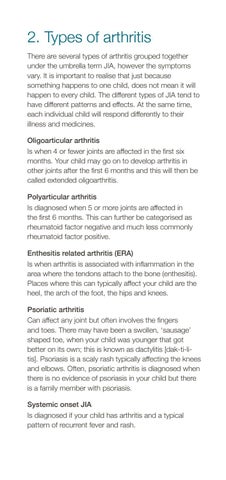2. Types of arthritis There are several types of arthritis grouped together under the umbrella term JIA, however the symptoms vary. It is important to realise that just because something happens to one child, does not mean it will happen to every child. The different types of JIA tend to have different patterns and effects. At the same time, each individual child will respond differently to their illness and medicines. Oligoarticular arthritis Is when 4 or fewer joints are affected in the first six months. Your child may go on to develop arthritis in other joints after the first 6 months and this will then be called extended oligoarthritis. Polyarticular arthritis Is diagnosed when 5 or more joints are affected in the first 6 months. This can further be categorised as rheumatoid factor negative and much less commonly rheumatoid factor positive. Enthesitis related arthritis (ERA) Is when arthritis is associated with inflammation in the area where the tendons attach to the bone (enthesitis). Places where this can typically affect your child are the heel, the arch of the foot, the hips and knees. Psoriatic arthritis Can affect any joint but often involves the fingers and toes. There may have been a swollen, ‘sausage’ shaped toe, when your child was younger that got better on its own; this is known as dactylitis [dak-ti-litis]. Psoriasis is a scaly rash typically affecting the knees and elbows. Often, psoriatic arthritis is diagnosed when there is no evidence of psoriasis in your child but there is a family member with psoriasis. Systemic onset JIA Is diagnosed if your child has arthritis and a typical pattern of recurrent fever and rash.
Issuu converts static files into: digital portfolios, online yearbooks, online catalogs, digital photo albums and more. Sign up and create your flipbook.
